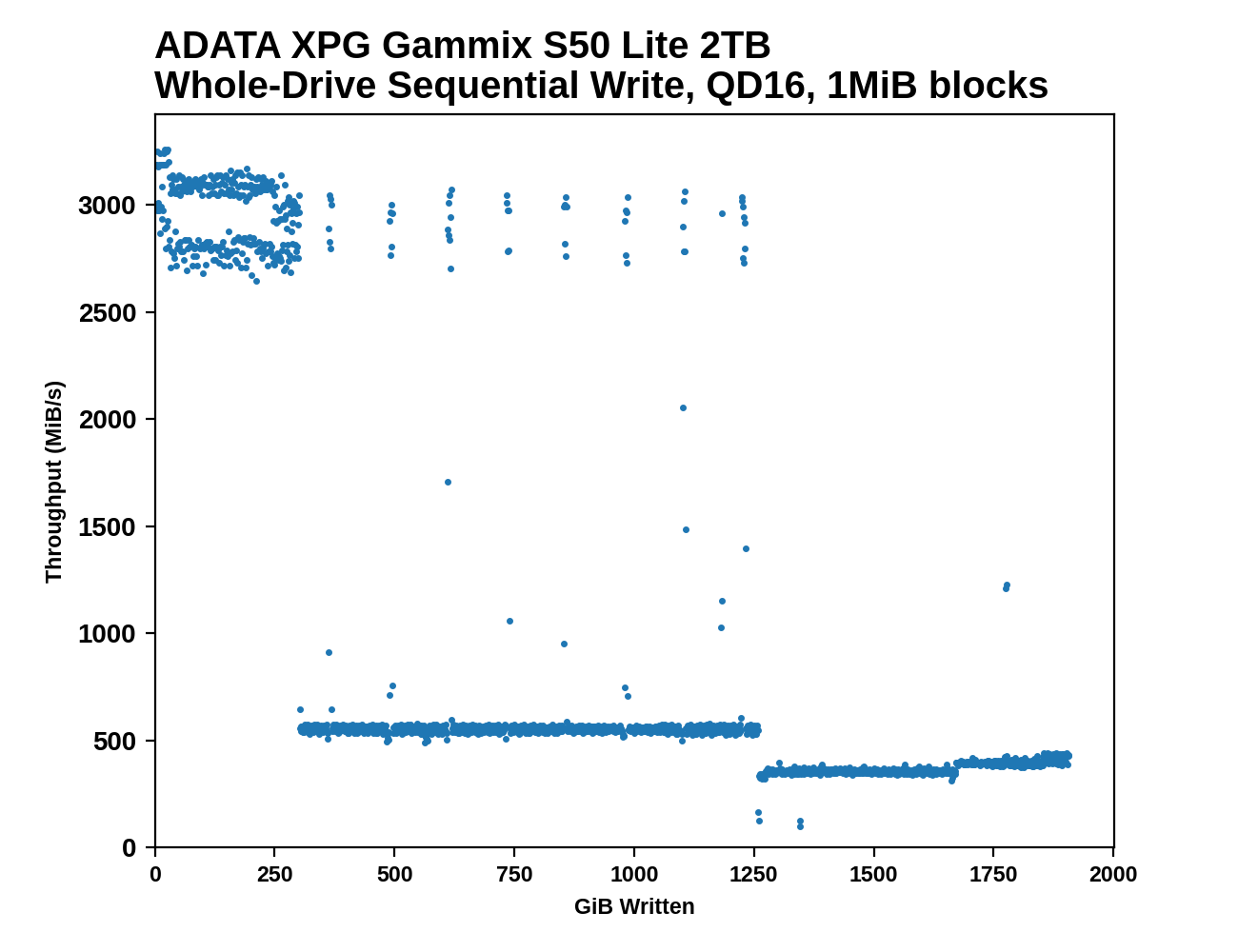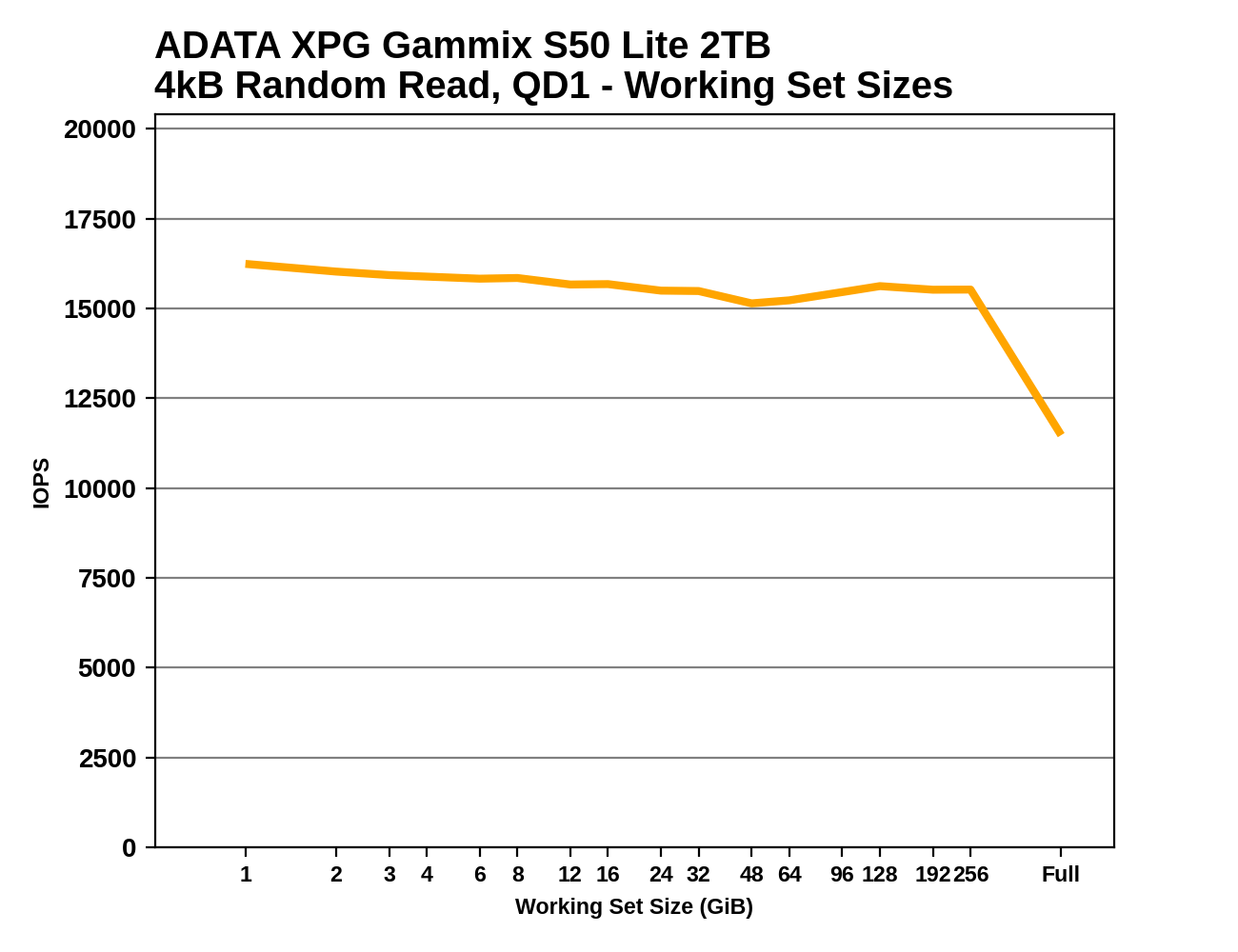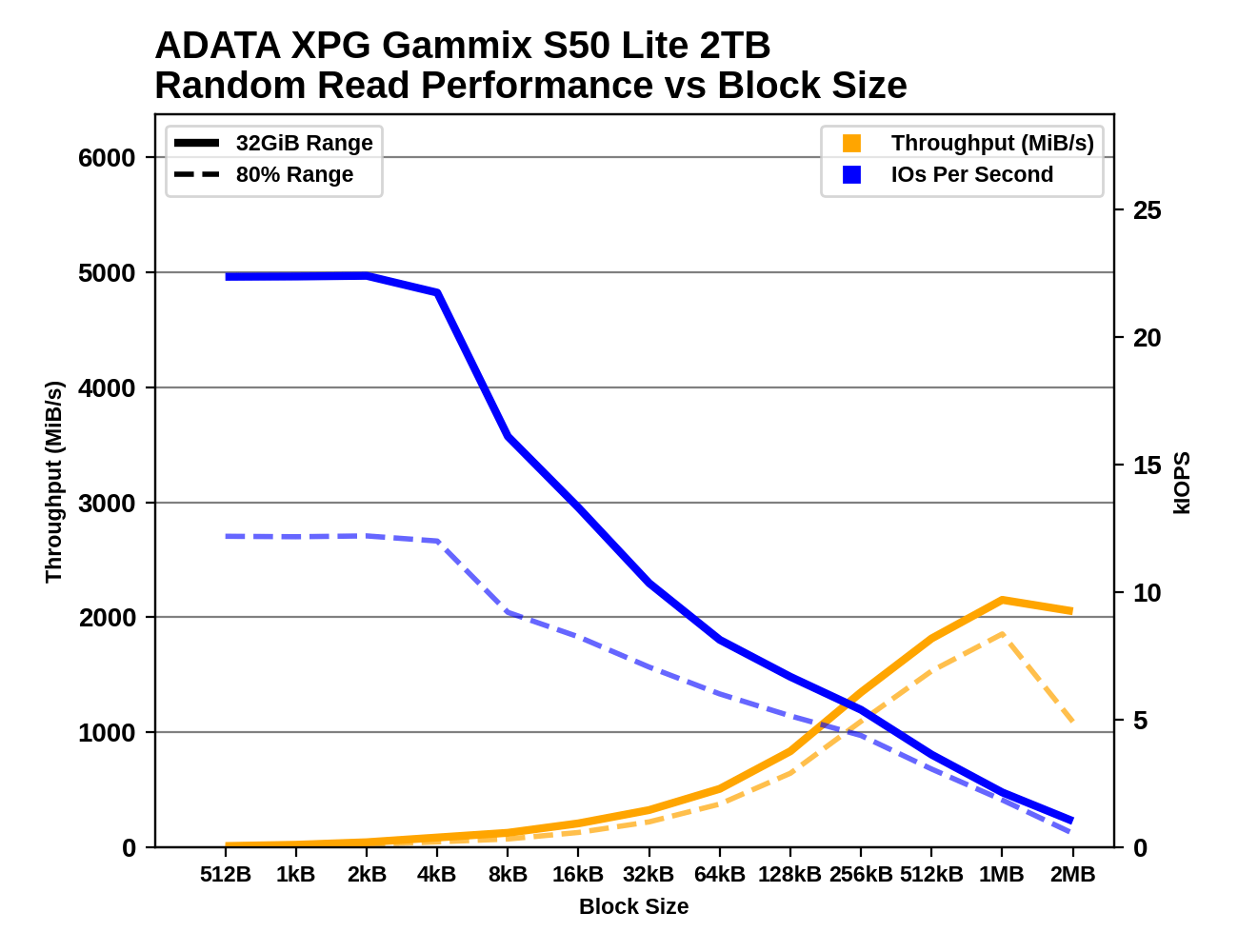The ADATA GAMMIX S50 Lite 2TB SSD Review: Mainstream PCIe Gen4
by Billy Tallis on April 30, 2021 8:00 AM ESTAdvanced Synthetic Tests
Our benchmark suite includes a variety of tests that are less about replicating any real-world IO patterns, and more about exposing the inner workings of a drive with narrowly-focused tests. Many of these tests will show exaggerated differences between drives, and for the most part that should not be taken as a sign that one drive will be drastically faster for real-world usage. These tests are about satisfying curiosity, and are not good measures of overall drive performance. For more details, please see the overview of our 2021 Consumer SSD Benchmark Suite.
Whole-Drive Fill
 |
|||||||||
| Pass 1 | |||||||||
| Pass 2 | |||||||||
The ADATA XPG Gammix S50 Lite shows an almost QLC-like performance drop when the SLC cache runs out after about 300GB: it falls down to SATA speeds. But even though its post-cache write speed is half of what we're used to seeing from TLC drives (most of which use controllers with 8 channels rather than 4), the S50 Lite still has a big lead over the two QLC drives in this bunch.
On the second pass of filling the drive, the S50 Lite's SLC cache is good for only about 14GB and the post-cache performance is much less consistent, with frequent drops below 100MB/s and spikes back up to SLC speeds around 3GB/s.
 |
|||||||||
| Average Throughput for last 16 GB | Overall Average Throughput | ||||||||
Working Set Size
 |
|||||||||
The S50 Lite has excellent random read latency for smaller working sets, beating all but two of the drives in this bunch. But the consequences of having only 1GB of DRAM for a 2TB drive show up at the end of the test, where the random read performance falls off sharply once the reads span the entire drive rather than just a small slice.
Performance vs Block Size
 |
|||||||||
| Random Read | |||||||||
| Random Write | |||||||||
| Sequential Read | |||||||||
| Sequential Write | |||||||||
The S50 Lite offers the same random read IOPS for all the IO block sizes from 512 bytes up to 4kB, but when testing random writes there's a clear preference for 4kB block sizes rather than anything smaller. Rather surprisingly, sequential reads with 4kB block sizes are far slower than for slightly smaller or larger block sizes; it would appear that the drive assumes 4kB reads will be random IO, and skips whatever caching or prefetching is active when using other block sizes.










93 Comments
View All Comments
FunBunny2 - Wednesday, May 5, 2021 - link
"every dollar spent on QLC is a dollar not spent on TLC -- nor MLC."it's been ages since I looked, but I'd wager that not even Enterprise RDBMS Storage Appliances are built with SLC any more. where did it all go? :)
Oxford Guy - Thursday, May 6, 2021 - link
SLC is an extreme example for most workloads. MLC is a far more enlightening one for consumers, as is the transition from planar to 3D TLC.Wereweeb - Saturday, May 1, 2021 - link
That is not economies of scale, that is market share. What you want is not to make TLC cheaper, but to boycott QLC.I wouldn't have disagreed with you when QLC came out. But right now I'd consider it good enough for most consumers, regardless of it being technically inferior to TLC.
The truth is, there just isn't any real world difference in performance between modern SSD's when it comes to the tasks a typical consumer faces. Only gamers and workstations benefit from TLC, and while it's natural to want to prevent it from becoming a "Luxury product" like MLC did, I think that there will always be demand for SSD's with higher endurance and throughput than QLC.
If you want to spread awareness about the negative aspects of QLC, do it intelligently, instead of acting like a conspiracy theory weirdo.
Wereweeb - Saturday, May 1, 2021 - link
Actually, to correct myself: there are SSD's that are objectively bad and should be banished from this dimension, they're called DRAMless SATA SSD's. But thankfully, that issue has already has been sorted out by history.TheinsanegamerN - Monday, May 3, 2021 - link
That exact same argument was sued for MLC when TLC came out, and we all saw what happened to MLC.QLC is "cheaper" and more importantly has far less endurance then TLC. Built in obsolescence. It's a horrible product for consumers, slower then TLC, especially when the drive fills up, and isnt noticeably cheaper for th econsumer then TLC is.
QLC is garbage, and outside of extreme capacity drives like sabarent's rocket q 8TB, makes no sense.
Wereweeb - Wednesday, May 5, 2021 - link
A 2TB TLC SSD's warranty can cover for 667 Gigabites of writes per day for 5 years. Which consumer will exceed that? Chia miners? How much data have you written into your computer today?The existing MLC capacity has merely been redirected to enterprise consumers, who actually DO need to entirely rewrite their SSD's daily. And for those cases there's also Optane and the new low-latency SLC (Z-NAND).
Give QLC SSD's some dedicated SLC + a tiering software and it beats TLC drives in endurance. The Enmotus FuzeDrive P200 does exactly that and ot has an endurance of 3,600 TBW, or 1 DWPD. Two to three times the warrantied endurance of your typical TLC drive.
That's the future we're headed towards. QLC for bulk storage, tiered with SLC or an NVRAM (Optane or competitor) for hot storage.
Plus, IIRC there is a 8TB QLC SSD that refuses to fold data from the SLC cache into QLC until it *needs to*, so if you fill less than 2TB of data it essentially behaves like a pSLC SSD. You might have to ask NewMaxx for the details (And to fact-check me) tho.
Wereweeb - Wednesday, May 5, 2021 - link
Plus, the warrantied storage is typically VERY conservative, and is only supposed to stop the enterprise people from buying the cheaper and lower-binned consumer SSD's.So I expect that in most consumer workloads the FuzeDrive is going to roughly match the endurance of TLC, which itself is more than sufficient for your typical consumer to use for over 10 years - at which point the SSD will either have failed from other problems, or be old outdated garbage that might not even fit in a modern computer.
Oxford Guy - Thursday, May 6, 2021 - link
I expect the Zip drive and the Deathstar hard drive from IBM.The Zip drive was a massive market success despite being an extremely shoddy and unreliable design. It should be unbelievable (and isn't) that a product that bad was allowed to become so common.
Expect the worst. Companies are in business to 'sell less for more'. If they could sell you an old boot fished out of a toxic lake rather than a computer, for the same money, they would -- in a New York minute.
Oxford Guy - Thursday, May 6, 2021 - link
When you end up with bits of tech that are better than half-baked trash like the Zip drive then be pleasantly surprised. Don't be surprised when tech like the Zip drives gives you the click of death. Inadequate product quality is one of the results of inadequate regulation.GeoffreyA - Thursday, May 6, 2021 - link
"Deathstar hard drive from IBM"I believe you're referring to the Deskstar's famous temperatures?